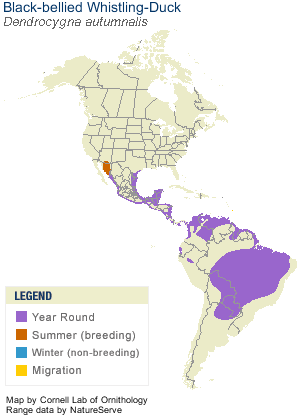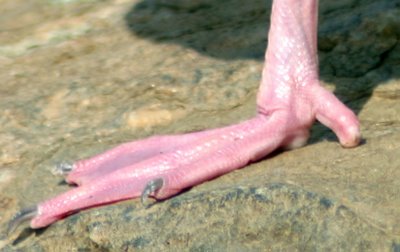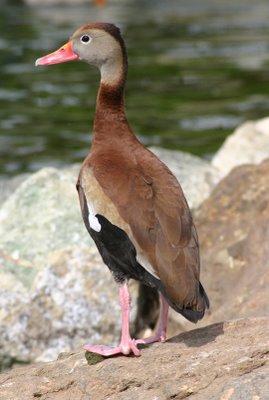Black-Bellied Whistling Duck in Maryland
Sometimes birds wind up in unexpected places. It's one of the greatest treats in birding, to wake up one day and hear on the grapevine or, more specifically, the MDOsprey listserv, that some bird that usually doesn't stray from Florida or California or Canada has dropped into our neighborhood.

The word is for this 'extralimital', and it happens for a number of reasons. The most common, I believe, is that birds somehow get caught in a storm or a weather front that pushes them out of their normal range. It is certainly common for migrating birds to surf a weather front up or down make their trip a little easier, and hurricanes and storms coming off the ocean commonly blow seabirds close to shore. It's kind of funny, actually, to picture a little duck taking a short flight back to his nest, getting caught in some wind and ending up across the country...
Also common are 'irruptions', where many individuals of a single species are found in faraway places. Late last year hundreds of Cave Swallows, normally residing in Texas, wound up in the Northeast. It appears that the same thing may be happening now, but with a different species. Today I went up to Gaithersburg, MD to have a look at a bird who, for one reason or another, is about a thousand miles away from it's normal home: a Black-Bellied Whistling Duck.
 Black-Bellied Whistling Ducks
Black-Bellied Whistling Ducks are small, gooselike ducks that usually reside in tropical areas from extreme southern Texas down through the Amazon rainforests in Brazil. They are chocolate brown with a grey face and (you guessed it) a black belly. Whistling ducks, of which there are two species which can be found in the US (black-bellied and fulvous), get their name from the high-pitched whistle-y call. The black-bellied duck is one of the few US ducks that perches and nests in trees.

A beautiful bird, and very approachable. The duck landed at a small pond behind the
Rio & Washingtonian Center in Gaithersburg, MD. The pond is already home to at least 50 tame Canada Geese and Mallards, and the BBWD seems to enjoy very much the relaxed atmosphere of the pond, as well as the frequent feedings from kids with bread or popcorn.
Actually, many birders have raised the question of whether or not the duck seems a little too comfortable. There is an issue as to whether or not the bird is an escapee from a local breeder or zoo. Since there are no leg bands or clipped wings, the focus of the detective work on this bird has fallen on the nails of the back toes. Cutting the toenails or part of the back toe off a bird to mark it as captive is a common occurrence, and the Rio bird does not appear to have any toenails on its hind toes. Here's a picture I took this morning:

Now, just because this bird doesn't have toenails does not necessarily mean that it's an escapee. There is discussion (without resolution as of yet) that female BBWD have very small, colorless nails. Additionally, some birders see the Rio bird as having 'nubs' which may be caused from the wear of standing on rocks all day.
The most important piece of evidence to support this bird being wild (and therefore countable under ABA rules) is a flock of 12 BBWDs that appeared on a farm in Suffolk, VA yesterday. This occurrence, which is just as rare as a single bird in Maryland, could mean that we are in the middle of an irruption. Whatever the case, it's a beautiful bird and one that is very rarely found in this part of the world. If you are reading this and haven't had a chance to see the bird, to do before he catches another storm and ends up in Alaska.










